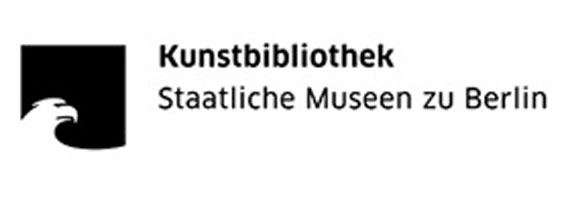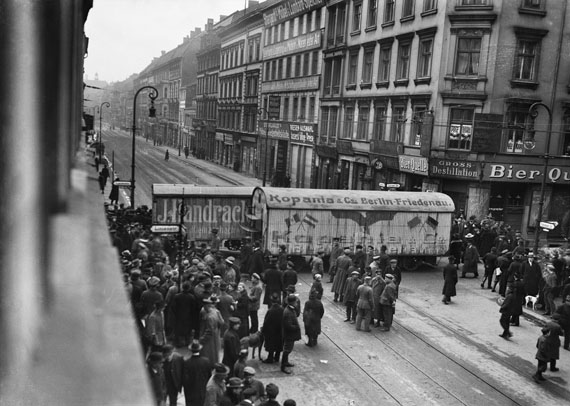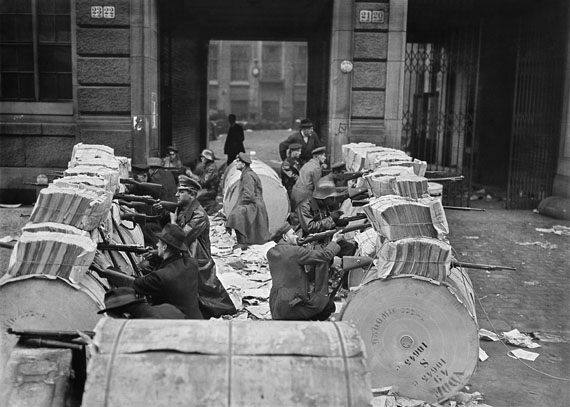
© Staatliche Museen zu Berlin, Kunstbibliothek – Photothek Willy Römer / Willy Römer
Berlin in the 1918/19 Revolution / Berlin in der Revolution 1918/19
Photography, Film, Entertainment Culture / Fotografie, Film, Unterhaltungskultur
Walter Gircke » Georg und Otto Haeckel » Willy Römer » & others
Exhibition: 9 Nov 2018 – 3 Mar 2019
Thu 8 Nov 19:00

Museum für Fotografie
Jebensstr. 2
10623 Berlin
+49 (0)30-266424242
mf@smb.spk-berlin.de
www.smb.museum/mf
Tue-Sun 11-19, Thu 11-20

© Staatliche Museen zu Berlin, Kunstbibliothek – Photothek Willy Römer / Gebrüder Haeckel
"Berlin in the 1918/19 Revolution"
Photography, Film, Entertainment Culture
Exhibition: 9 November, 2018 – 3 March, 2019
Opening: Thursday, 8 November, 7pm
An exhibition of the Kunstbibliothek, supported by the Hauptstadtkulturfonds
Exhibition partners: bpk-Bildagentur and ullstein bild
The revolution in winter and spring 1918/19 was decided in the streets of the imperial capital, Berlin. Berliners celebrated the abdication of the German Emperor with demonstrations in front of the Reichstag and the palace on November 9th, 1918, in the newspaper quarter in January 1919 rolls of printing paper were used by the Spartacists to erect barricades against approaching government troops, after fighting had ceased, a large funeral procession crossed Frankfurter Allee to the cemetery in Friedrichsfelde. Press photographers were omnipresent with their big plate cameras, taking shots of orators in the crowd, soldiers behind machine-guns, vehicles carrying party posters in the National Assembly election campaign, and destroyed buildings and ravaged squares. At the same time, everyday life in the city went on. People went to the numerous cinemas with their expanding repertoire of films, enjoyed themselves at revues and cabarets, and danced the two-step and the foxtrot. The exhibition in the Museum für Fotografie shows both a photographic visual history of the revolution in Berlin and a panorama of the entertainment culture of those months.
The brothers Otto and Georg Haeckel were the most important press photographers during the first days of the revolution. As experienced war reporters, they reacted quickly to cover the spontaneous rallies on Unter den Linden and in front of the palace. The photographers worked without assignment and offered their images to publishers like Mosse or Ullstein. There are few visual records of the fighting itself. Rather, photographers took advantage of breaks in the fighting to recreate scenes on the barricades or with soldiers with readied weapons. The largest group of photos of the revolution of which the original contact prints survive is by Willy Römer. One of his photographs was even taken immediately before his own arrest by a troop of Spartacists.
Weekly newsreels in cinemas across Germany reported on the rallies and demonstrations in Berlin, showed film portraits of the ministers of the new imperial government, and confirmed the restoration of order by showing scenes from everyday life in the streets of the capital. At the same time, they solicited votes for the National Assembly. Given lengthy production times, the feature films of winter 1918/19 do not yet reflect the revolution in any way. But the suspension of censorship enabled the production of new, more daring films, which, for example, opposed the criminal persecution of homosexuals.
As a reaction to the end of the war and without as yet reckoning with the dangers of the revolution and its fighting, an unprecedented desire for pleasure-seeking reigned in Berlin during the winter and spring of 1918/19. Besides opera houses and straight theatres, Berliners frequented the popular operetta and revue theatres, as well as cinemas; they also went to ballrooms and drinking holes to dance. Some revues reacted to current issues like the housing shortage and the strikes. The poverty of war invalids was also a subject of popular music. The song ‘Bein ist Trumpf’ from 1919 alludes to the fate of four men maimed in the war: the dance with a wooden leg or prosthesis amid the workings of a world-apparatus that turns and turns without end.�

© Staatliche Museen zu Berlin, Kunstbibliothek – Photothek Willy Römer / Willy Römer
"Berlin in der Revolution 1918/19"
Fotografie, Film, Unterhaltungskultur
Ausstellung: 9. November 2018 bis 3. März 2019
Eröffnung: Donnerstag, 8. November, 19 Uhr
Eine Ausstellung der Kunstbibliothek, gefördert vom Hauptstadtkulturfonds
In Kooperation mit bpk-Bildagentur und ullstein bild
Die Revolution im Winter und Frühjahr 1918/19 entschied sich in den Straßen der Reichshauptstadt Berlin. Mit Demonstrationen vor Reichstag und Schloss feierten die Berlinerinnen und Berliner am 9. November 1918 die Abdankung des Kaisers, im Zeitungsviertel wurden im Januar 1919 aus Druckpapierrollen die Barrikaden der Spartakisten gegen die anrückenden Regierungstruppen errichtet, über die Frankfurter Allee zog nach dem Ende der Kämpfe der große Trauerkondukt zum Friedhof in Friedrichsfelde. Mit dabei waren immer die Pressefotografen, die mit ihren großen Plattenkameras die Redner in der Menge, die Soldaten hinter den Maschinengewehren, die Plakatwagen der Parteien für die Wahlen zur Nationalversammlung sowie die zerstörten Häuser und verwüsteten Plätze aufnahmen. Doch gleichzeitig ging der Alltag in der Stadt weiter, besuchten die Menschen die vielen Kinos mit ihrem expandierendem Filmangebot, amüsierten sich in Revuen und Kabaretts, tanzten Two-Step und Foxtrott. Die Ausstellung im Museum für Fotografie zeigt gleichermaßen eine fotografische Bildgeschichte der Revolution in Berlin wie ein Panorama der Unterhaltungskultur dieser Monate.
In den ersten Tagen der Revolution waren die Gebrüder Otto und Georg Haeckel die wichtigsten Pressefotografen. Als erfahrene Kriegsreporter begleiteten sie reaktionsschnell die spontanen Kundgebungen Unter den Linden und vor dem Schloss. Die Fotografen arbeiteten ohne Auftrag und boten Verlagen wie Mosse oder Ullstein ihre Aufnahmen an. Belege von den Kampfhandlungen selbst gibt es nur wenige. Eher stellten die Fotografen in den Kampfpausen Szenen mit Soldaten mit schussbereiten Waffen oder an den Barrikaden nach. Von Willy Römer sind die meisten Aufnahmen der Revolution in Originalkontaktabzügen überliefert. Eine seiner Fotografien entstand sogar unmittelbar vor seiner eigenen Festnahme durch einen Trupp Spartakisten.
In den Kinos berichteten die Wochenschauen deutschlandweit von den Kundgebungen und Demonstrationen in Berlin, brachten Film-Porträts der Minister der neuen Reichsregierung und zeigten als Beweis für die wieder hergestellte Ordnung Alltagsszenen aus den Straßen der Hauptstadt. Gleichzeitig warben sie für die Nationalversammlung. Aufgrund der längeren Produktionsabläufe boten die Spielfilme im Winter 1918/19 noch keinen Reflex auf die Revolution. Doch ermöglichte die Aufhebung der Zensur die Produktion neuer, gewagter Filme, die sich etwa gegen die strafrechtliche Verfolgung Homosexueller richteten.
Als Reaktion auf das Ende des Krieges und ohne zunächst den Gefahren der Revolutionskämpfe Rechnung zu tragen, herrschte im Winter und Frühjahr 1918/19 in Berlin eine beispiellose Vergnügungssucht. Neben Opernhäusern und Sprechtheatern frequentierten die Berlinerinnen und Berliner die populäreren Operetten- und Revuetheater, die Kinos, aber auch Ballhäuser oder Kaschemmen, um dort zu tanzen. Dabei gab es auch Revuen, die tagesaktuell auf Themen wie die Wohnungsnot und die Streiks reagierten. Die Misere der Kriegsinvaliden war gleichfalls ein Sujet der populären Musik. In dem Lied Bein ist Trumpf aus dem Jahr 1919 wird das Schicksal vieler kriegsversehrter Männer angesprochen: der Tanz mit dem Holzbein oder der Prothese im Getriebe eines sich immer weiter drehenden Weltgefüges.�

© Staatliche Museen zu Berlin, Kunstbibliothek – Photothek Willy Römer / Willy Römer

Elections for the National Assembly in Berlin: agitation by the actress Senta Söneland in front of the railway station Zoologischer Garten, January 1919
© bpk / Walter Gircke